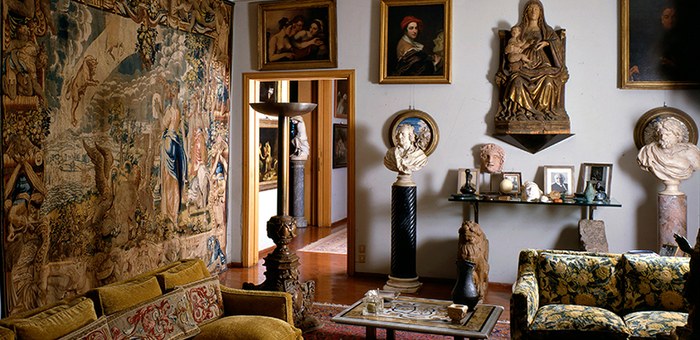«I don't believe in the artwork as a thing of beauty but as a historical document».
«...I repudiate the label of 'collector', it doesn't fit me at all. I see the art objects among which I live as a kind of environmental appendix, props to my profession as a connoisseur and sometime art historian.
Leaving aside the spurious breed of investor collectors (to me detestable and with whom I have nothing in common), anyone setting up an authentic collection follows a specific design... Whether it's medals or stamps, the insignia of Orders, uniforms, engravings or Byzantine weights, your authentic collector is guided by the dictates of a solid literature based on catalogues and repertories. ... There is also another kind of genuine collector who acquires figurative artworks as and when he chances upon them on the market, the aim being to form a homogeneous whole ... In that case too the choice is based on a clear plan – something I've never gone in for. ...I've never bothered about attributions – quite the reverse: many pieces only got baptised after I'd seen them day in, day out, for years, problems of an art historical nature».
Whereas with some connoisseurs, like Roberto Longhi, the collection faithfully mirrors their field of study, not so the extraordinary medley of objects Zeri amassed in the course of over fifty years.
Virtually no goldwork, few enough 15th-16th-century works, but Baroque canvases galore, paintings from foreign schools and artists, sculpture above all (including the 46-work donation to the Accademia Carrara), archaeological items (one thinks of the 400 Roman inscriptions still at his Mentana villa, and the ten funerary reliefs from Palmyra that he donated to the Vatican Museums), tapestries, ancient carpets, Byzantine silverware.
As a whole it testifies to his all-round curiosity and vast knowledge of even remote culture; and this rounds out the perception we have of the man and the art historian through his scientific writings. Again, the off-beat originality of his choice of paintings highlights Zeri's scholarly interest in anti-academic artists and odd-balls of Italian history of art.
Rather than a collection to pore over, what Federico Zeri put together in his Mentana home is a workshop, a laboratory where he daily honed his unrivalled connoisseur's eye.
Programme
Bologna | Federico Zeri Foundation
Thursday 7 October, 5.30 p.m.
Maria Cristina Rodeschini & Paolo Plebani
FEDERICO ZERI AND THE ACCADEMIA CARRARA
Thursday 21 October, 5.30 p.m.
Barbara Jatta
FEDERICO ZERI AND THE VATICAN MUSEUMS
Thursday 18 November, 5.30 p.m.
Annalisa Zanni & Andrea di Lorenzo
FEDERICO ZERI AND THE POLDI PEZZOLI MUSEUM
Thursday 25 November, 5.30 p.m.
Francesca Alberti
FEDERICO ZERI AND THE ACCADEMIA DI FRANCIA, ROME
Entry free: first come, first served.
The meetings are also being broadcast live on Facebook
Access upon presentation of the green pass.
